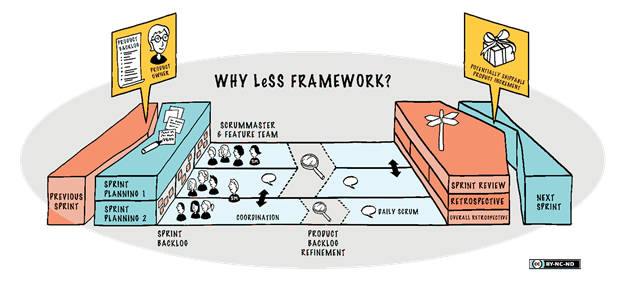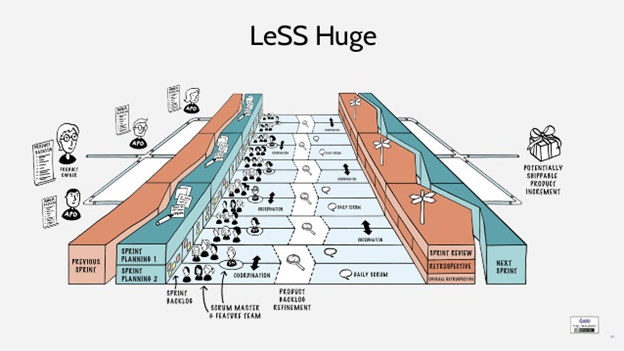LeSS adalah kerangka kerja Agile yang ringan untuk memperluas Scrum ke lebih dari satu tim. Dimulai pada tahun 2005, Bas Vodde dan Craig Larman mengembangkan kerangka LeSS setelah menggunakan prinsip dan aturan Scrum pada proyek berskala besar. Tujuan mereka adalah untuk mengembangkan proyek berskala besar dengan sukses sambil tetap berada dalam batasan Scrum.
LeSS dibangun di atas prinsip Scrum seperti empirisme, lintas fungsi tim yang mengelola diri sendiri dan menyediakan kerangka kerja untuk menerapkannya secara skala. Ini menyediakan aturan struktural yang sederhana, panduan, dan eksperimen tentang cara mengadopsi Scrum dalam lingkungan pengembangan produk berskala besar. LeSS hanya memiliki beberapa aturan dan dua kerangka kerja: LeSS dan LeSS Huge.
- LeSS Basic: 2–8 Tim
- LeSS Huge: 8+ Tim
Perbedaannya terletak pada ukuran total tim yang terlibat. Basic LeSS adalah dua hingga delapan tim yang masing-masing terdiri dari delapan orang yang bekerja pada pengembangan produk yang sama. LeSS Huge adalah hingga lebih dari 2.000 orang yang bekerja pada pengembangan produk yang sama. Dengan kata lain, seberapa besar Anda ingin yang besar? LeSS dapat memperbesar atau memperkecil scrum untuk bekerja di banyak lingkungan.
kerangka LeSS
Gambar di bawah ini menggambarkan kerangka dasar LeSS. Jumlah tim pengembangan bervariasi dari dua hingga delapan. Satu pemilik produk mencakup hingga delapan tim dan setiap scrum master melayani hingga tiga tim.

Dalam kerangka LeSS, ada satu pemilik produk dan satu backlog produk untuk produk yang dapat dikirim secara lengkap. Pemilik produk tidak boleh bekerja sendiri dalam penyempurnaan backlog produk; dia didukung oleh beberapa tim pengembangan yang bekerja langsung dengan pelanggan/pengguna dan pemangku kepentingan lainnya. Semua prioritas melalui pemilik produk, tetapi klarifikasi dapat terjadi langsung antara tim dan pelanggan/pengguna serta pemangku kepentingan lainnya.
Sementara banyak dari LeSS tetap setia pada kerangka scrum satu tim, perbedaannya penting:
- Perencanaan Sprint dibagi menjadi dua bagian: Bagian 1 adalah umum untuk semua tim dan Bagian 2 adalah untuk setiap tim.
- Perencanaan sprint (Bagian 1) dibatasi hingga satu jam per minggu dari panjang sprint. Meskipun tidak semua pengembang diharuskan hadir, mereka tidak dilarang, dan setidaknya dua anggota per tim sprint hadir, bersama dengan pemilik produk. Anggota tim perwakilan kemudian kembali dan membagikan informasi mereka kepada tim masing-masing.
- Perencanaan sprint independen (Bagian 2) dan scrum harian terjadi, dan anggota dari tim yang berbeda dapat menghadiri pertemuan satu sama lain untuk memfasilitasi berbagi informasi.
- Koordinasi antar tim diputuskan oleh tim dengan preferensi untuk koordinasi yang terdesentralisasi dan informal dibandingkan dengan koordinasi terpusat. Penekanan ada pada jaringan informal yang melibatkan percakapan antar tim, mentor komponen, pelancong, pengintai, dan ruang terbuka.
- Penyempurnaan backlog dilakukan untuk backlog produk secara keseluruhan dengan perwakilan dari setiap tim pengembangan dan pemilik produk. Penyempurnaan backlog tim individu juga terjadi di tingkat tim individu tetapi penyempurnaan backlog multi-tim terjadi setiap sprint dan merupakan praktik kunci dalam LeSS.
- Tinjauan sprintdilakukan dengan perwakilan dari setiap tim dan pemilik produk.
Scrum vs Kerangka LeSS
Basic LeSS sangat mirip dengan Scrum satu tim, hanya diperluas. Dalam LeSS ada satu Backlog Produk, satu Pemilik Produk, satu Definisi Selesai, satu sprint umum, dan satu PSP (Produk yang Berpotensi Dikirim) increment di akhir sprint. Karena semua tim bekerja untuk menerapkan produk yang sama, semua tim bersifat lintas fungsi dengan sedikit, jika ada, tim spesialis. Singkatnya, semua tim bekerja untuk menghasilkan produk yang dapat dikirim secara umum setiap sprint.
Ada perbedaan dalamScrum dan LeSS. Dalam LeSS, perencanaan sprint dilakukan secara terpisah dalam dua pertemuan. Dalam satu pertemuan, Pemilik Produk bertemu dengan perwakilan dari semua tim yang mengelola di antara mereka sendiri untuk memutuskan item backlog produk mana yang akan mereka kerjakan di sprint berikutnya. Beberapa pekerjaan yang sama mungkin dibagikan dengan dua tim atau lebih. Pertemuan kedua, yang diadakan secara paralel atau segera setelah yang pertama, adalah pertemuan semua anggota setiap tim. Untuk tujuan koordinasi, pertemuan tim dapat diadakan di bagian yang berbeda dari area yang sama, tetapi secara terpisah. Pengaturan ini berguna ketika dua tim yang melakukan pekerjaan pada tugas yang sama selama sprint berikutnya, mungkin memiliki pertanyaan atau memerlukan klarifikasi dari tim lain.
kerangka LeSS Huge
LeSS Huge dibangun di atas kerangka LeSS dengan mengoptimalkan untuk delapan tim atau lebih. Dengan LeSS Huge, langit adalah batasnya sejauh ukuran tim proyek secara keseluruhan. Beberapa ribu orang dapat bekerja pada satu proyek. LeSS Huge memperkenalkan beberapa konsep baru dan tantangan untuk mengelola backlog berskala besar. Ini adalah area kebutuhan, backlog produk area, dan pemilik produk area.
Tim scrum dibagi menjadi area kebutuhan pelanggan utama. Setiap area memiliki satu pemilik produk area dan empat hingga delapan tim scrum. (Memiliki setidaknya empat tim di setiap area kebutuhan mencegah terlalu banyak optimasi lokal dan kompleksitas.) Satu pemilik produk keseluruhan dan beberapa pemilik produk area membentuk tim pemilik produk. Gambar di bawah ini menggambarkan kerangka LeSS Huge.

Seperti dalam scrum dan dalam LeSS yang lebih kecil, Anda memiliki satu produk, satu definisi selesai, satu pemilik produk (area), dan satu sprint. LeSS Huge adalah tumpukan LeSS untuk setiap area kebutuhan. Setiap area kebutuhan menggunakan LeSS, dan kumpulan semua area kebutuhan ada di LeSS Huge. Beberapa perbedaannya adalah
- Pertemuan perencanaan pemilik produk terjadi sebelum pertemuan perencanaan sprint.
- Pertemuan tingkat area ditambahkan. Perencanaan sprint, tinjauan, dan pertemuan retrospektif dilakukan di tingkat area, dan penyempurnaan backlog produk tingkat area terjadi.
- Tinjauan dan retrospektif sprint secara keseluruhan yang melibatkan semua tim dilakukan. Tinjauan ini mengkoordinasikan pekerjaan dan proses secara keseluruhan di area program produk.
LeSS memungkinkan penerapan scrum dan skala dengan cara yang sebagian besar sesuai dengan Prinsip Agile. Beberapa elemen dari kerangka scrum ditegakkan dengan pembelajaran empiris, umpan balik singkat, organisasi mandiri, dan kolaborasi serta koordinasi yang efektif.
Alat kepemimpinan juga ada di LeSS untuk keputusan yang baik yang memaksimalkan ROI; memberikan nilai kepada pelanggan; dan menciptakan tim yang bahagia dan berkelanjutan.
LeSS Basic vs LeSS Huge
LeSS Huge mirip dengan Basic LeSS, kecuali bahwa karena ukuran ada dua atau lebih Pemilik Produk Area. Pemilik Produk Area dan satu Pemilik Produk keseluruhan membentuk tim Pemilik Produk. Tergantung pada ukuran, mungkin juga ada Manajer Produk tambahan.
Setiap area kebutuhan idealnya memiliki empat hingga delapan tim. Karena pekerjaan yang dilakukan di bawah LeSS Huge biasanya melibatkan beberapa tim area dari empat hingga delapan tim, dan Basic LeSS adalah dua hingga delapan tim, fungsi dasar tim di bawah Basic LeSS dan LeSS Huge adalah sama.
Kelola Scrum dengan Kanvas Scrum Skala Besar
Tim Anda dapat menggunakan alat agile untuk mengotomatiskan seluruh perangkat lunak manajemen proyek Agile menggunakan Visual Paradigm untuk memaksimalkan efisiensi proyek Scrum dengan kanvas proses visual yang dirancang untuk proyek berskala besar.
Ambil tur cepat untukKanvas Scrum Besar — Kelola seluruh Kerangka LeSS Anda dalam satu halaman tunggal.
Sumber daya:
- Perbandingan Kerangka Agile yang Diperbesar
- Apa saja 10 Prinsip dari Kerangka LeSS?
- Panduan Scrum yang Komprehensif
- Pengantar LeSS
This post is also available in Deutsch, English, Español, فارسی, Français, 日本語, Polski, Portuguese, Ру́сский, Việt Nam, 简体中文 and 繁體中文.













